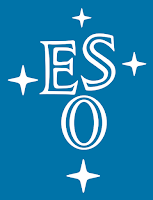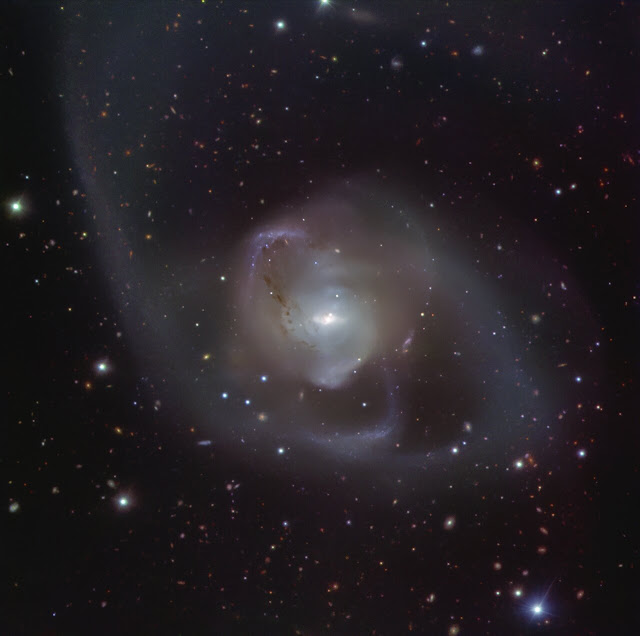ESO - European Southern Observatory logo.
Aug 16, 2022
NGC 7727’s spectacular galactic dance as seen by the VLT
ESO’s Very Large Telescope (VLT) has imaged the result of a spectacular cosmic collision — the galaxy NGC 7727. This giant was born from the merger of two galaxies, an event that started around a billion years ago. At its centre lies the closest pair of supermassive black holes ever found, two objects that are destined to coalesce into an even more massive black hole.
Just as you may bump into someone on a busy street, galaxies too can bump into each other. But while galactic interactions are much more violent than a bump on a busy street, individual stars don’t generally collide since, compared to their sizes, the distances between them are very large. Rather, the galaxies dance around each other, with gravity creating tidal forces that dramatically change the look of the two dance partners. ‘Tails’ of stars, gas and dust are spun around the galaxies as they eventually form a new, merged galaxy, resulting in the disordered and beautifully asymmetrical shape that we see in NGC 7727.
Close-up view of the nearest pair of supermassive black holes
The consequences of this cosmic bump are spectacularly evident in this image of the galaxy, taken with the FOcal Reducer and low dispersion Spectrograph 2 (FORS2) instrument at ESO’s VLT. While the galaxy was previously captured by another ESO telescope, this new image shows more intricate details both within the main body of the galaxy and in the faint tails around it.
In this ESO VLT image we see the tangled trails created as the two galaxies merged, stripping stars and dust from each other to create the spectacular long arms embracing NGC 7727. Parts of these arms are dotted with stars, which appear as bright blue-purplish spots in this image.
Wide-field view of the region of the sky hosting NGC 7727
Also visible in this image are two bright points at the centre of the galaxy, another telltale sign of its dramatic past. The core of NGC 7727 still consists of the original two galactic cores, each hosting a supermassive black hole. Located about 89 million light-years away from Earth, in the constellation of Aquarius, this is the closest pair of supermassive black holes to us.
The black holes in NGC 7727 are observed to be just 1600 light-years apart in the sky and are expected to merge within 250 million years, the blink of an eye in astronomical time. When the black holes merge they will create an even more massive black hole.
Bumps in the heaven
The search for similarly hidden supermassive black hole pairs is expected to make a great leap forward with ESO’s upcoming Extremely Large Telescope (ELT), set to start operating later this decade in Chile’s Atacama Desert. With the ELT, we can expect many more of these discoveries at the centres of galaxies.
Our home galaxy, which also sports a supermassive black hole at its centre, is on a path to merge with our closest large neighbour, the Andromeda Galaxy, billions of years from now. Perhaps the resulting galaxy will look something similar to the cosmic dance we see in NGC 7727, so this image could be giving us a glimpse into the future.
Journey to the closest pair of supermassive black holes
More information
This image was created as part of the ESO Cosmic Gems programme, an outreach initiative to produce images of interesting, intriguing or visually attractive objects using ESO telescopes, for the purposes of education and public outreach. The programme makes use of telescope time that cannot be used for science observations. All data collected may also be suitable for scientific purposes, and are made available to astronomers through ESO’s science archive.
The European Southern Observatory (ESO) enables scientists worldwide to discover the secrets of the Universe for the benefit of all. We design, build and operate world-class observatories on the ground — which astronomers use to tackle exciting questions and spread the fascination of astronomy — and promote international collaboration in astronomy. Established as an intergovernmental organisation in 1962, today ESO is supported by 16 Member States (Austria, Belgium, the Czech Republic, Denmark, France, Finland, Germany, Ireland, Italy, the Netherlands, Poland, Portugal, Spain, Sweden, Switzerland and the United Kingdom), along with the host state of Chile and with Australia as a Strategic Partner. ESO’s headquarters and its visitor centre and planetarium, the ESO Supernova, are located close to Munich in Germany, while the Chilean Atacama Desert, a marvellous place with unique conditions to observe the sky, hosts our telescopes. ESO operates three observing sites: La Silla, Paranal and Chajnantor. At Paranal, ESO operates the Very Large Telescope and its Very Large Telescope Interferometer, as well as two survey telescopes, VISTA working in the infrared and the visible-light VLT Survey Telescope. Also at Paranal ESO will host and operate the Cherenkov Telescope Array South, the world’s largest and most sensitive gamma-ray observatory. Together with international partners, ESO operates APEX and ALMA on Chajnantor, two facilities that observe the skies in the millimetre and submillimetre range. At Cerro Armazones, near Paranal, we are building “the world’s biggest eye on the sky” — ESO’s Extremely Large Telescope. From our offices in Santiago, Chile we support our operations in the country and engage with Chilean partners and society.
Links:
FOcal Reducer and low dispersion Spectrograph 2 (FORS2): https://www.eso.org/public/teles-instr/paranal-observatory/vlt/vlt-instr/fors/
Extremely Large Telescope (ELT): https://elt.eso.org/
Photos of the VLT: http://www.eso.org/public/images/archive/category/paranal/
For journalists: subscribe to receive our releases under embargo in your language: https://www.eso.org/public/outreach/pressmedia/#epodpress_form
For scientists: got a story? Pitch your research: http://www.eso.org/sci/publications/announcements/sciann17463.html
ESO Cosmic Gems programme: http://www.eso.org/public/outreach/gems.html
Images Credits: ESO/Voggel et al./Digitized Sky Survey 2. Acknowledgement: Davide De Martin/ESO/VST ATLAS team. Acknowledgement: Durham University/CASU/WFAU/Video Credits: ESO/L. Calçada ; N. Risinger (skysurvey.org); Digitized Sky Survey 2; VST ATLAS team; Voggel et al. Music: Azul Cobalto/Text Credits: ESO/Bárbara Ferreira.
Best regards, Orbiter.ch





